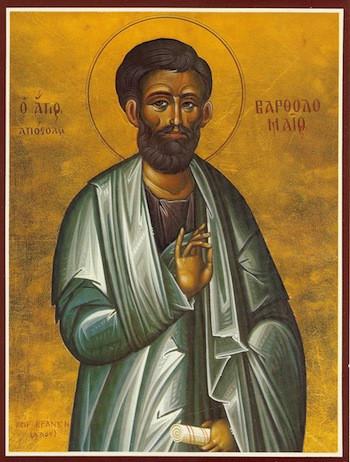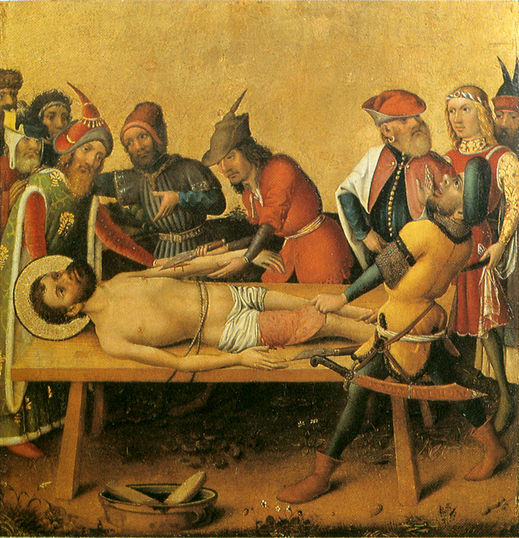St Bartholomew, the Apostle, also referred to as Nathaniel (modern scholarship suggests) has his feast day on August 24th in the Roman Rite. The description of his life is in newadvent.org here. In the gospels he is described as coming to know Jesus through St Philip and when he beheld him, Our Lord described him as a ‘true Isrealite in whom there is no guile’.

In Eastern icons, as above, he is protrayed as a middle-aged man with a scroll. A scroll indicates holy Wisdom, and so is often shown in the hands of the Old Testament prophets, but is also commonly seen in the hands of the Apostoles. Both were given wisdom from God – the prophets through visions, the Apostles through meeting and knowing Jesus Christ. Later Saints may also be shown holding scrolls if they were also known for prophecy, wisdom, and imparting divine knowledge to others.
By tradition he preached in Armenia and India and was martyred in Armenia by being flayed and skinned alive. This gives rise to some particularly gruesome medieval representations of his martydom on a surgeon’ table as in this 14th century painting.

For this reason also, especially in Western portrayals, the symbol of St Bartholomew is the knife and a flaying chain. The painting below is by Tiepolo.

Some representations show him almost as an artist’s ecorche, with skin completely removed (and draped over his arm as a cloak) to show the muscles belief, sometimes in anatomical detail.


A book called the Golden Legend describes his precisely as having black hair, a thick beard with a few grey hairs and a wide and straight nose. This is reflected more in Western protrayals. The paintings below are by El Greco and Ribera respectively.


The Golden Legend was a collection of legenedary lives of saints written in the 13th century by Jacopo de Voragine and read widely. Not always historically accurate it nevertheless it inspired devotion to the saints of a sort that enhanced the faith of the people in a deep and true way. As newadvent.org says:
If we are to judge the “Golden Legend” from an historicalstandpoint, we must condemn it as entirely uncritical and hence of no value, except in so far as it teaches us that the people of those times were an extremely naive and thoroughly religious people, permeated with an unshakable belief in God’s omnipotence and His fatherly care for those who lead a saintly life.
If, on the other hand, we view the “Golden Legend” as an artistically composed book of devotion, we must admit that it is a complete success. It is admirably adapted to enhance our love and respect towards God, to foster our devotion towards His saints, and to animate us with a holyzeal to follow their example. The chief object of Jacopo de Voragine and of other medieval hagiologists was not to compose reliable biographies or to write scientific treatises for the learned, but to write books of devotion that were adapted to the simple manners of the common people. It is due to a wrong conception of the purpose of the “Golden Legend” that Luis Vives (De causis corruptarum artium, c. ii), Melchior Canus (De locis theologicis, xi, 6), and others have severely denounced it; and to a true conception that the Bollandists (Acts SS., January, I, 19) and many recent hagiologists have highly praised it.
This is one of a series of articles written to highlight the great feasts and the saints of the Roman Canon. All are connected to a single opening essay, in which I set out principles by which we might create a canon of art for Roman Rite churches and schema that would guide the placement of such images in a church. Read it here. In these I plan to cover the key elements of images of the saints of the Roman Canon – Eucharistic Prayer I – and the major feasts of the year.
For the fullest presentation of the principles of sacred art for the liturgy, take the Master’s of Sacred Arts, www.Pontifex.University.
